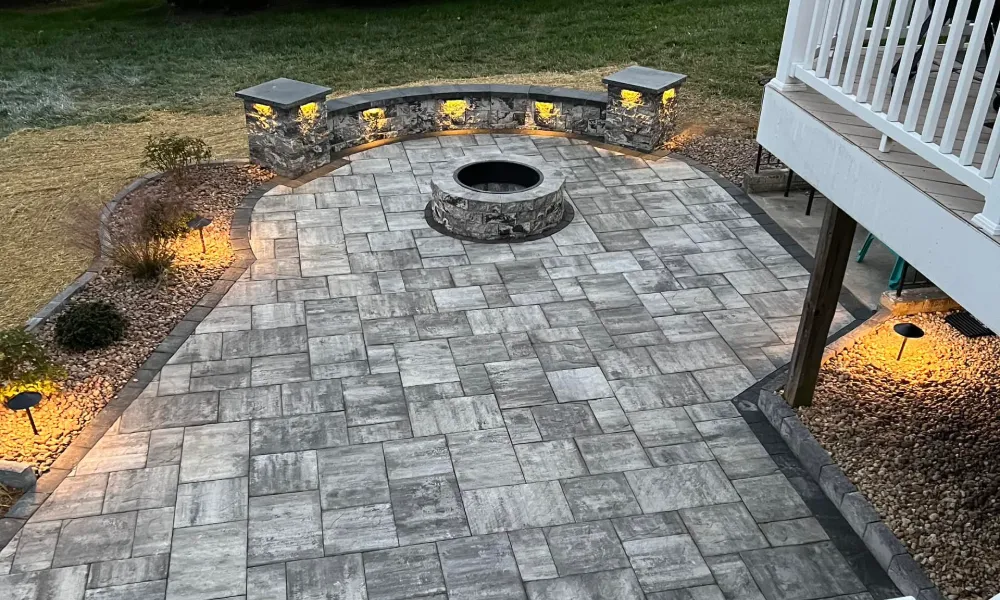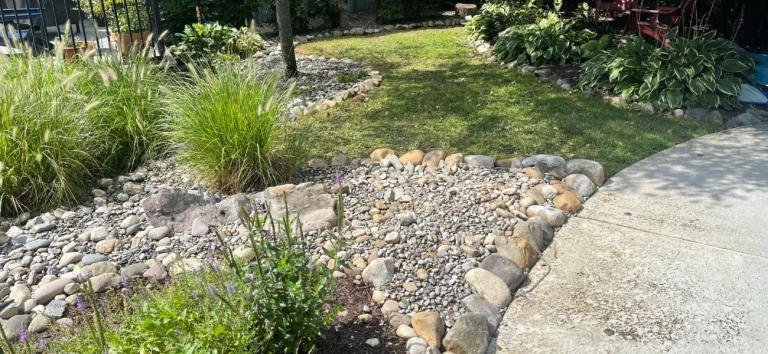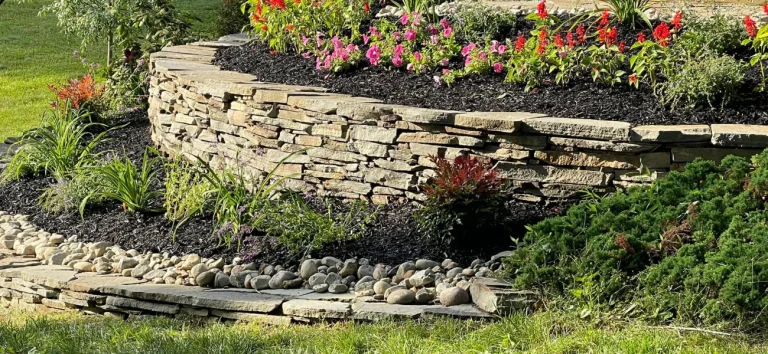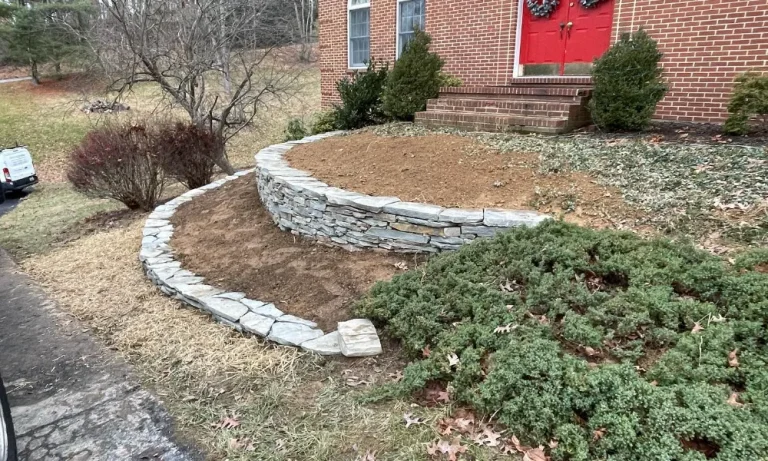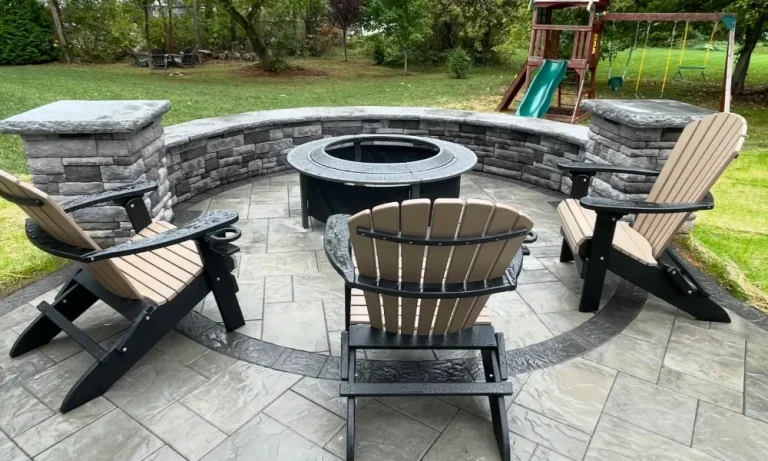Extend Or Replace Your Existing Paver Patio?
A paver patio is one of the best investments you can make in your outdoor living space. Over time, however, you may find yourself wondering whether to extend your current patio or replace it altogether. This decision depends on several factors, including the available space, the structural integrity of your existing patio, and your long-term goals for your outdoor area. Let’s break down the key considerations to help you make an informed choice.
Assessing Your Current Patio
Before considering whether to extend your existing paver patio or replace it entirely, it's essential to start with a thorough evaluation of its current condition. The patio must be structurally sound and free from significant issues, as these factors will determine whether an extension is feasible or if a full replacement is the better option.
Is the Current Patio Structurally Sound?
Begin by inspecting the visible condition of your patio. Look for telltale signs of structural problems, such as:
-
- Uneven pavers: These may indicate shifting in the base due to poor installation, soil erosion, or freeze-thaw cycles.
- Cracks: Cracks in the pavers or joints could be superficial or a sign of deeper structural issues, especially if water has seeped into the base.
- Sinking or settling: Areas of the patio that have dipped below the surrounding surface could point to an unstable base or inadequate compaction during installation.
- Poor drainage: If water pools on the patio after rain, it can cause damage over time and needs to be addressed before any extension or replacement.
A structurally sound patio with a properly compacted base provides a stable foundation for extending the surface. However, if these issues are extensive or beyond repair, replacing the patio may be more practical than trying to build upon a compromised foundation.
Are There Any Underlying Issues?
Even if your patio appears fine on the surface, hidden issues can create challenges during construction or in the future. Common underlying problems include:
-
- Drainage concerns: Poor drainage not only damages pavers over time but can also lead to issues like water pooling around your home's foundation. Adding an extension to your patio without resolving drainage problems can exacerbate these issues.
- Tree roots: Nearby trees with aggressive root systems can disrupt the patio's foundation, leading to uneven surfaces or lifted pavers. Removing or managing these roots is critical before considering an extension.
- Base condition: The quality of the patio's base is important. An improperly compacted or eroded base will make any extension unstable unless the base is redone correctly.
Addressing these problems before starting any work ensures that your paver patio remains durable and functional for years to come.
Does the Patio Meet Your Current Needs?
Reflect on how you currently use your patio and whether it still fits your lifestyle and outdoor living goals. For example:
-
- Entertaining: Do you host gatherings that feel cramped or limited by your current space? If so, extending the patio to accommodate more seating or an outdoor kitchen might make sense.
- Daily use: If your patio is primarily used for quiet relaxation but lacks features like a firepit or shaded area, you might consider redesigning it during an extension.
- Family growth: If your family has grown or your outdoor activities have changed, your patio may no longer meet your needs, making an upgrade or replacement worth considering.
Thinking about both the functional and aesthetic aspects of your patio can help guide your decision to either extend or replace the space. Matching the design to your current lifestyle ensures that the investment enhances your outdoor experience.
Deciding to Extend or Replace
When it comes to enhancing your outdoor living space, deciding whether to extend your existing patio or replace it entirely depends on several factors. These considerations can help you make the best decision for your property and lifestyle.
Available Space for Extension
One of the first things to evaluate is whether you have enough space to expand your patio. Consider the following:
-
- Property boundaries: Ensure that the expansion stays within your property lines. Encroaching on a neighbor's property or community space can lead to disputes or legal challenges.
- Zoning laws: Local regulations may restrict how much of your yard can be covered by hardscaping. For example, impervious surface limits in some areas might prevent you from adding a large extension.
- HOA regulations: If you live in a neighborhood with a homeowners’ association, there may be rules about patio size, materials, or design. Reviewing these guidelines before planning can save time and frustration.
If you’re unsure about any of these factors, a professional contractor can provide guidance. They can help with measurements, check local codes, and determine the feasibility of your desired extension.
Can the Existing Materials Be Matched?
Matching new pavers to the existing patio can be challenging due to natural weathering and fading over time. Here are some strategies to overcome this issue:
-
- Color matching: Even within the same product line, variations in color can occur between batches. If an exact match is impossible, consider sourcing complementary colors or patterns.
- Texture and style: If the original pavers are no longer available, explore alternative options that harmonize with the existing patio. For instance, choose a similar texture or material to maintain a cohesive appearance.
- Creative solutions: Using contrasting designs, such as a border or decorative inlay, can make the transition between the old and new sections appear intentional and visually appealing.
A skilled contractor can offer design ideas and help you source materials that achieve the best aesthetic outcome.
What Kind of Extension Do You Want?
The type of extension you choose will depend on how you envision using the additional space. Consider these popular options:
-
- Larger seating area: Perfect for hosting guests or creating a cozy outdoor dining spot.
- Firepit or lounge zone: Extend your patio to include a designated space for a firepit or outdoor fireplace, adding warmth and ambiance.
- Outdoor kitchen: If you enjoy cooking and entertaining outdoors, an extension can provide the perfect space for a grill, prep station, or even a full kitchen setup.
- Multi-functional space: You might want a mix of areas, such as a dining zone and a lounging area, to cater to different activities.
Clearly defining how you want to use the extended space will help guide design decisions and ensure the finished patio meets your needs.
When to Consider Full Replacement
In some cases, extending your patio might not be the most practical or cost-effective solution. Consider replacing the patio entirely if:
-
- The existing patio has significant damage: Issues like cracking, sinking, or poor drainage may make a replacement necessary to ensure long-term stability and aesthetics.
- The materials are outdated: If your patio’s design or materials feel dated, replacing it allows you to start fresh with a modern look.
- Matching materials is impossible: When new materials can’t blend seamlessly with the old, a replacement ensures a cohesive design.
- You want a new layout or functionality: A replacement provides an opportunity to completely rethink the patio’s size, shape, and features to better suit your lifestyle.
A full replacement might involve a higher upfront cost, but it ensures a polished, durable result and eliminates the challenges of integrating old and new sections.
Whether you choose to extend or replace, a thoughtful approach and the guidance of an experienced contractor will help you create an outdoor space that enhances your home and meets your needs for years to come. Would you like me to refine or expand further on any of these points?
Potential Problems During Expansion or Replacement
While expanding or replacing your paver patio can enhance your outdoor living space, it's important to be aware of potential challenges that may arise during the process. Being prepared for these issues will help you make informed decisions and avoid unexpected surprises.
Structural Challenges
One of the most common obstacles during a patio extension or replacement is dealing with the ground beneath the patio. Several factors can complicate the project:
-
- Uneven ground: If the area where you plan to extend the patio is uneven, additional grading may be necessary to create a stable foundation. Uneven ground can lead to improper drainage and instability if not corrected.
- Poor soil conditions: Certain soil types, such as clay or sandy soils, may require extra preparation, like soil stabilization or the addition of a gravel base, to prevent shifting or settling over time.
- Inadequate grading: Proper grading is essential to direct water away from your home and prevent pooling on the patio. If the original patio was not graded correctly, this issue must be addressed before extending or replacing it.
Addressing these challenges upfront, with the help of a professional contractor, ensures a stable and long-lasting patio that can withstand the elements.
Matching Issues
As discussed earlier, matching new materials to an existing patio can be difficult due to factors like weathering, fading, and discontinued product lines. Here are some strategies to navigate this issue:
-
- Creative design elements: Incorporate design features like a decorative border, inlay, or pattern to intentionally differentiate the new section. This approach can make the mismatch look purposeful and even add visual interest.
- Contrasting materials: Use materials that complement, rather than match, the original patio. For example, pairing a brick extension with a stone border around the old patio can create a cohesive yet distinct look.
- Transition zones: Create a clear transition between the old and new sections using plant beds, seating walls, or a change in elevation, such as steps or retaining walls, to separate the areas visually and functionally.
A skilled landscape designer or contractor can help you choose the best approach to seamlessly blend the old and new sections.
Timeline and Costs
The time and cost involved in extending or replacing your patio depend on several factors:
-
- Patio extensions: These typically take less time and are more affordable than a full replacement. However, the project timeline can stretch if additional work is needed to address grading, soil conditions, or drainage.
- Full replacements: Replacing a patio is usually a larger investment, as it involves removing the old materials, preparing the ground, and installing the new patio. While the upfront cost may be higher, this option allows for a completely new design and ensures long-term durability.
- Unforeseen challenges: Hidden issues, such as unstable ground or drainage problems, can add to both the timeline and the budget. It’s important to factor in some flexibility for unexpected expenses.
Working with a reliable contractor who provides a detailed estimate and timeline can help minimize surprises and keep your project on track.
By understanding and planning for these potential challenges, you can ensure a smoother process and a finished patio that enhances your outdoor living space. Do you want me to expand further or refine any of these sections?
Additional Considerations
When deciding whether to extend or replace your paver patio, it’s essential to think beyond the immediate project. Consider how your outdoor space will serve you in the future, potential upgrades that could maximize its usability and beauty, and whether professional help is worth the investment.
Future Needs and Lifestyle Changes
Your outdoor living space should adapt to your changing needs over time. Consider the following:
Entertaining and gatherings: If you love hosting outdoor parties, will the extended or replaced patio provide enough space for larger gatherings or additional seating?
Family growth: For growing families, a larger patio can create space for kids to play, enjoy family meals, or even add features like a firepit or outdoor dining area.
New features: Think about the possibility of incorporating outdoor kitchens, hot tubs, or seating walls in the future. A properly planned patio can provide the flexibility to accommodate these additions.
Aging in place: If you plan to stay in your home long-term, consider features that improve accessibility, like smooth transitions between patio areas, wide pathways, and low-maintenance materials.
Planning with the future in mind ensures that your investment meets both your current and long-term needs.
Enhancements and Upgrades
An extended or new patio is the perfect opportunity to enhance its functionality and aesthetic appeal. Here are some popular upgrades to consider:
Lighting: Add pathway lights, recessed lighting, or overhead string lights to extend usability into the evening. Outdoor lighting also improves safety and ambiance.
Seating walls: Integrate built-in seating to provide practical and stylish solutions for hosting larger groups.
Pergolas and shade structures: Create a more comfortable outdoor space by adding shade with a pergola or a pavilion. These structures can also support decorative lighting or climbing plants for added charm.
Greenery and landscaping: Surround your patio with flower beds, shrubs, or ornamental grasses for a natural, inviting feel. Consider incorporating planters or even a vertical garden.
Water features: A small fountain or pond can elevate the tranquil vibe of your patio. For larger patios, a water wall or cascading feature can make a stunning focal point.
Fire elements: Add a firepit, outdoor fireplace, or built-in fire table to extend patio use into cooler seasons.
Upgrades like these not only make your patio more enjoyable but can also boost your property’s value and curb appeal.
Professional Help vs. DIY
While a DIY approach might initially seem like a budget-friendly option, there are significant benefits to hiring a professional contractor for your patio project:
Seamless integration: Professionals have the skills and tools to blend new patio sections with existing ones or execute a flawless replacement. Achieving this level of polish can be difficult with a DIY effort.
Addressing challenges: Issues like poor drainage, uneven ground, or soil conditions require expertise to resolve effectively. Professionals can identify and address these problems to ensure long-term durability.
Quality craftsmanship: From proper base preparation to precise paver alignment, professionals bring experience and attention to detail that results in a high-quality finish.
Time savings: DIY projects often take longer than anticipated, especially if you encounter unforeseen problems. Hiring a contractor ensures the job is completed efficiently and correctly the first time.
Warranty and peace of mind: Many professional services include warranties on labor and materials, giving you confidence that your investment is protected.
While DIY might be suitable for minor repairs or landscaping, a professional is the best choice for significant projects like patio extensions or replacements.
By thinking ahead, enhancing functionality, and investing in professional expertise, you can create a paver patio that perfectly suits your lifestyle now and in the future. Let me know if you'd like help expanding any other sections!
Making the Decision
Deciding whether to extend or replace your patio requires careful consideration of several factors, including the current state of your patio, your budget, and your long-term goals. By weighing the pros and cons, setting clear priorities, and consulting with professionals, you can ensure your decision leads to an outdoor space you’ll love for years to come.
Weighing the Pros and Cons
Start by evaluating the advantages and disadvantages of extending versus replacing your patio:
Extending Your Patio
Pros:
- Cost-effective: Typically less expensive than a full replacement, as you’re adding on rather than starting from scratch.
- Quicker process: An extension usually requires less time than a full teardown and rebuild.
- Preserves existing patio: If your current patio is in good condition, extending it allows you to retain its design and character.
Cons:
- Matching challenges: It can be difficult to match new materials to existing ones due to fading, wear, or discontinued products.
- Limited scope: Extensions are constrained by the condition and size of the original patio. If there are existing issues, they may worsen over time.
Replacing Your Patio
Pros:
- Complete design freedom: A full replacement allows you to reimagine your outdoor space, incorporating modern designs and features.
- Durability: Starting fresh with updated materials and a well-prepared base ensures long-lasting results.
- Cohesive appearance: Avoid the challenge of blending old and new materials by designing a single, unified patio.
Cons:
- Higher cost: A full replacement typically requires a larger investment upfront.
- Longer timeline: Removing the old patio and building a new one can take more time.
Carefully weigh these factors against your needs, lifestyle, and how much use you get out of your patio.
Budget Considerations
Setting a clear and realistic budget is a key part of making the right decision. Consider the following tips:
- Prioritize essentials: Focus on features that enhance functionality, such as increasing usable space, improving drainage, or adding shade.
- Plan for upgrades: If budget allows, consider upgrades like built-in seating or lighting that can elevate your outdoor experience.
- Account for contingencies: Unexpected costs, such as addressing poor soil conditions or drainage issues, can arise during construction. Set aside a portion of your budget for these possibilities.
- Balance costs and value: Think about the return on investment. While a full replacement may cost more upfront, it can increase your home’s value and appeal in the long run.
Working within your budget doesn’t mean sacrificing quality. A professional contractor can help you maximize value while staying on track financially.
Expert Consultation
If you’re still unsure whether to extend or replace your patio, consulting a professional can provide clarity. Here’s how expert advice can help:
- Comprehensive assessment: A contractor can evaluate the structural integrity of your existing patio, identify potential issues, and recommend the best course of action.
- Tailored solutions: Professionals work with you to design a patio that fits your vision, lifestyle, and budget.
- Expert insight: They can provide creative ideas, suggest suitable materials, and ensure compliance with local regulations or HOA requirements.
- Peace of mind: With a professional on your side, you can feel confident that the project will be completed efficiently and to the highest standard.
At Harvest Outdoor Living, we specialize in helping homeowners create stunning, functional outdoor spaces. Whether you’re considering an extension or a full replacement, our team will work closely with you to develop a plan that meets your needs. Contact us today to schedule a consultation and get started!
Our Paver Patio Installation Service Area
Harvest Outdoor Living proudly serves the following areas in Maryland:
- Aberdeen
- Abingdon
- Bel Air
- Churchville
- Fallston
- Forest Hill
- Havre De Grace
- Jarrettsville
- Perry Hall
- White Marsh
As a trusted local contractor, we understand the unique needs and preferences of homeowners in these communities. Let us help you transform your outdoor space.
Your Patio Transformation Awaits
Deciding whether to extend or replace your paver patio requires careful evaluation of your needs, budget, and the condition of your current patio. No matter your choice, Harvest Outdoor Living can help you create a beautiful and functional outdoor space. Contact us today to schedule a free consultation and get started on your patio transformation!

